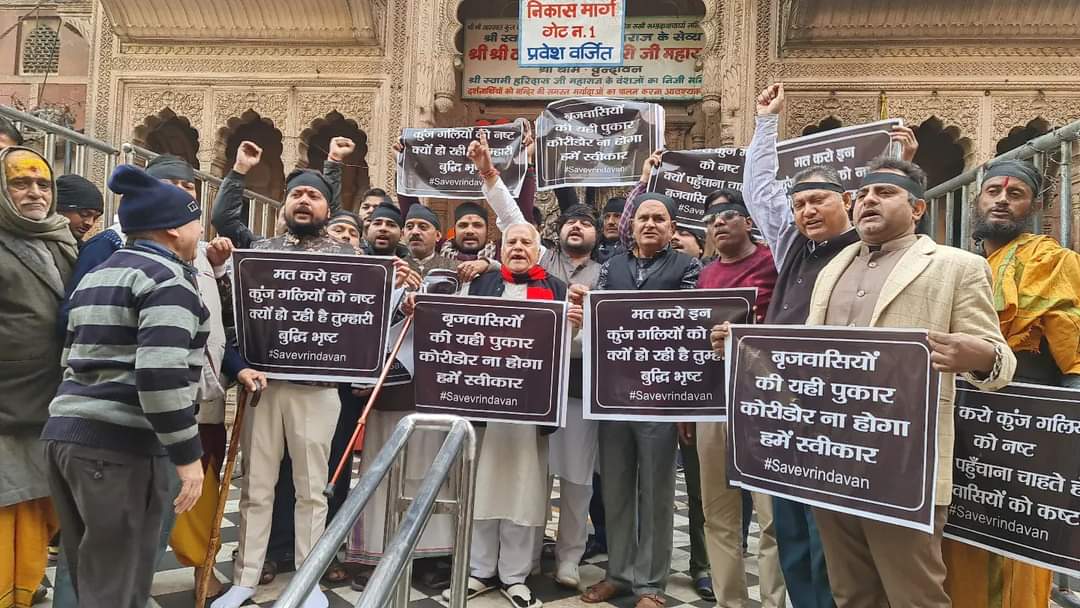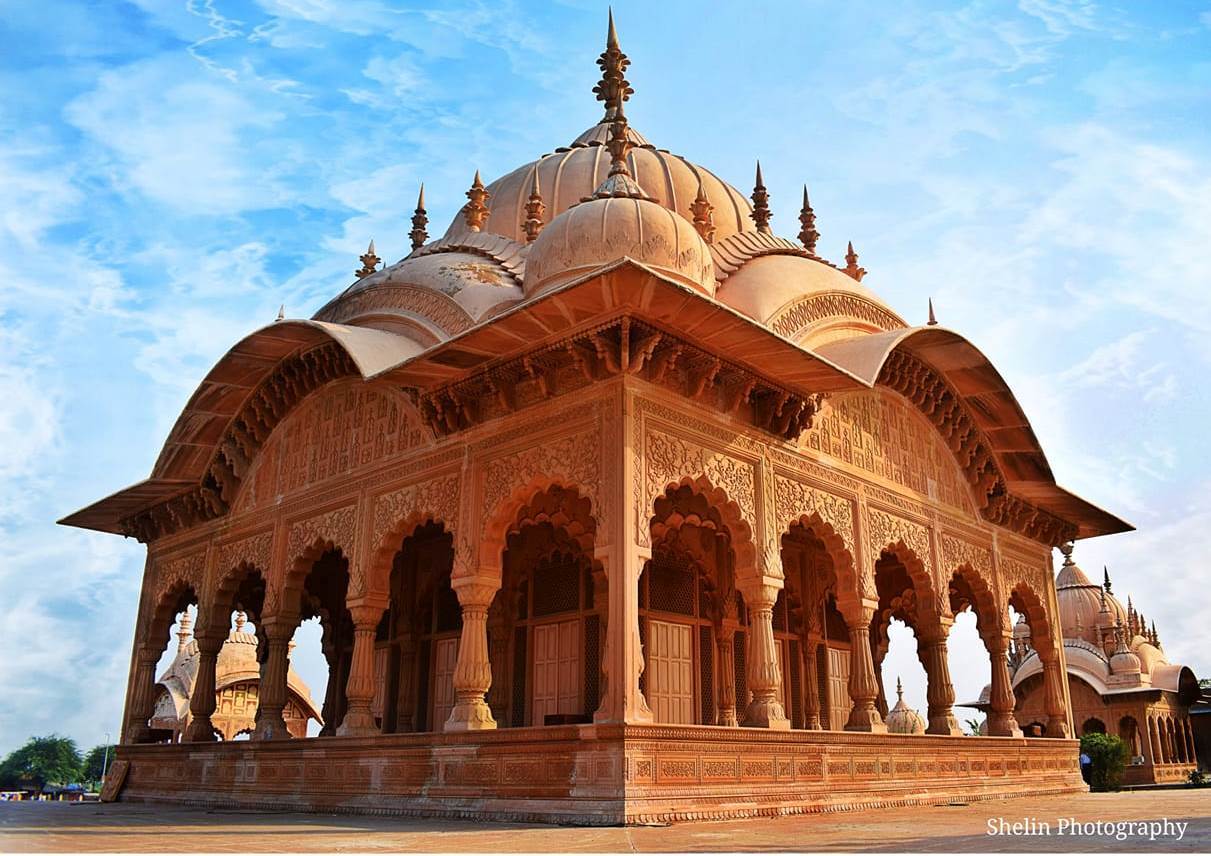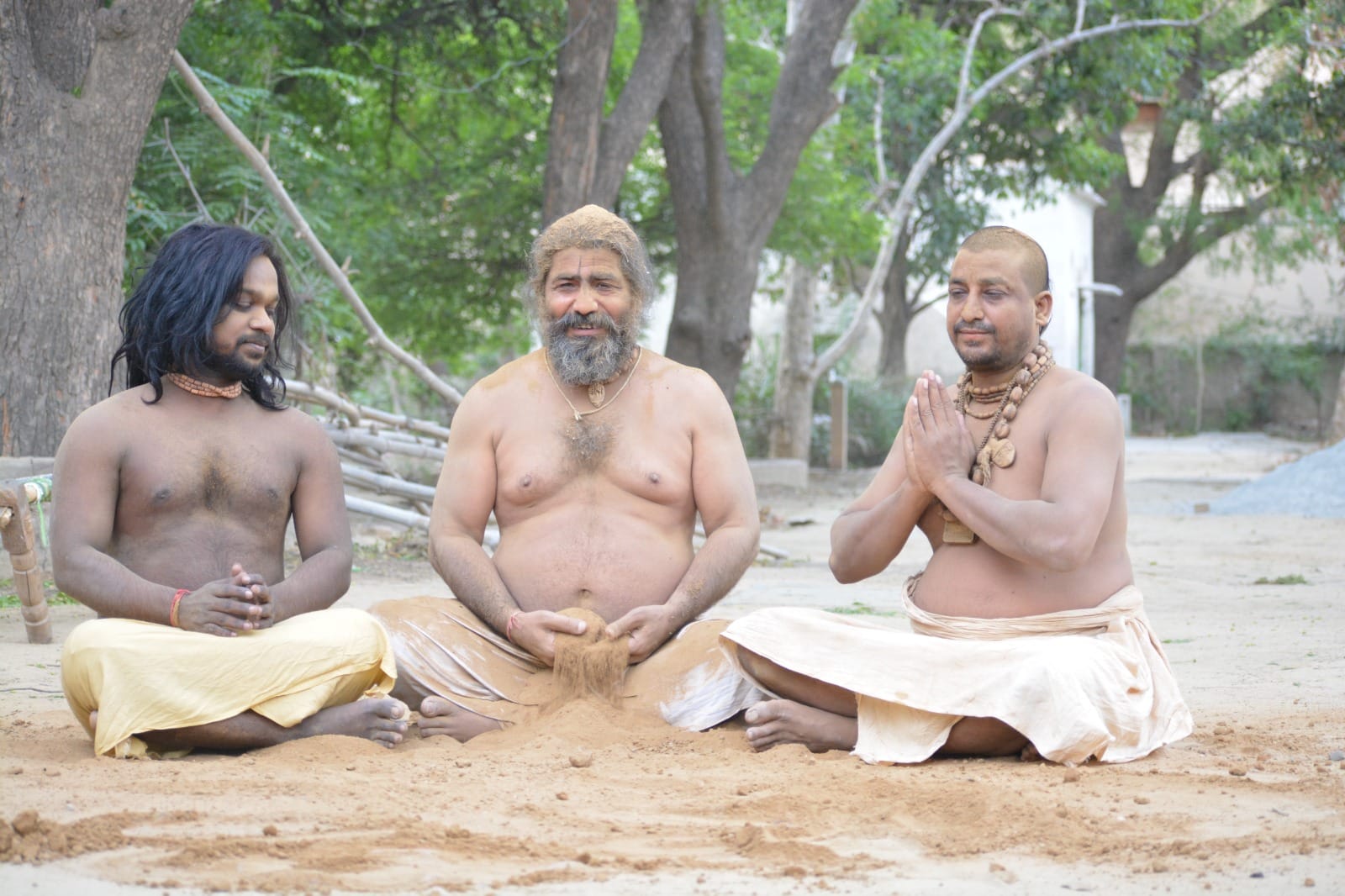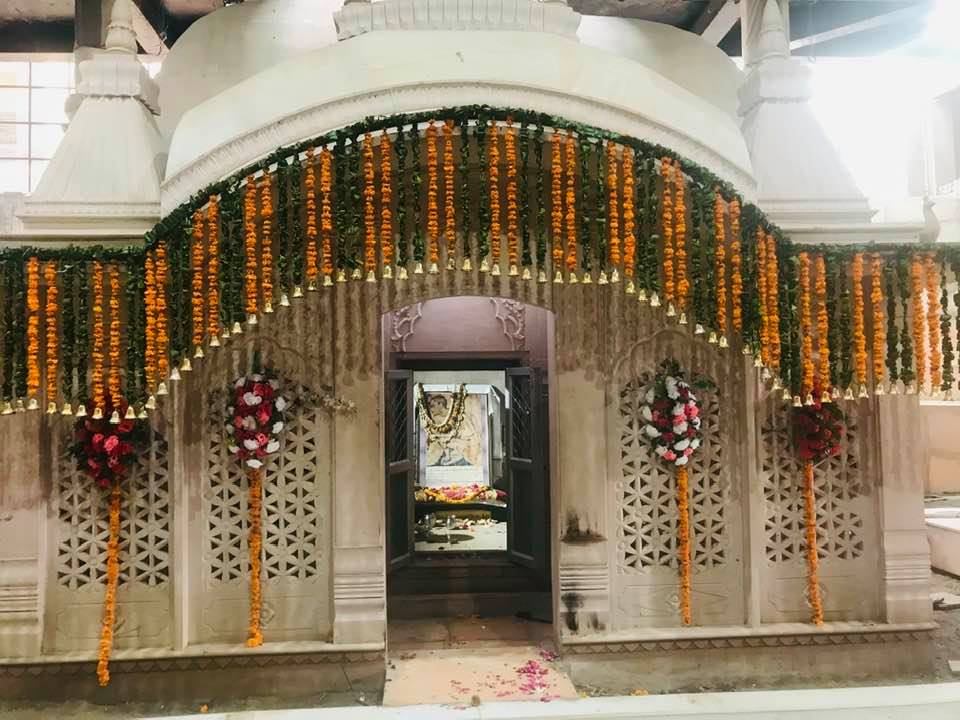2023.01.27 (Vrindavan Today News): Angry locals, temple goswamis, and business owners in Biharipura and surrounding areas have been protesting against the upcoming Banke Bihari Corridor. From peaceful demonstrations outside the temple, to ‘dharnas’ on Vidyapeeth Circle, to ‘kunj bihari shri haridas’ kirtans, the protests have morphed into outright threats of self immolation and causing damage to public property.
Viral videos of women threatening the PM and CM with self immolation along with children and family, and letters written in blood, have all been used to express their displeasure with the Corridor Project. People have also threatened to burn down bulldozers even before they enter the locality, and boycott local body elections.
The reasons behind their anger against the corridor are many. People are miffed with the fact that the corridor will destroy the kunj galis that are the beauty as well as the essence of Vrindavan. They argue that these winding lanes are not only an invaluable and distinct attribute of Vrindavan’s heritage, but are also sacred by virtue of the fact that they served as the stage for Radha and Krishna’s leelas.
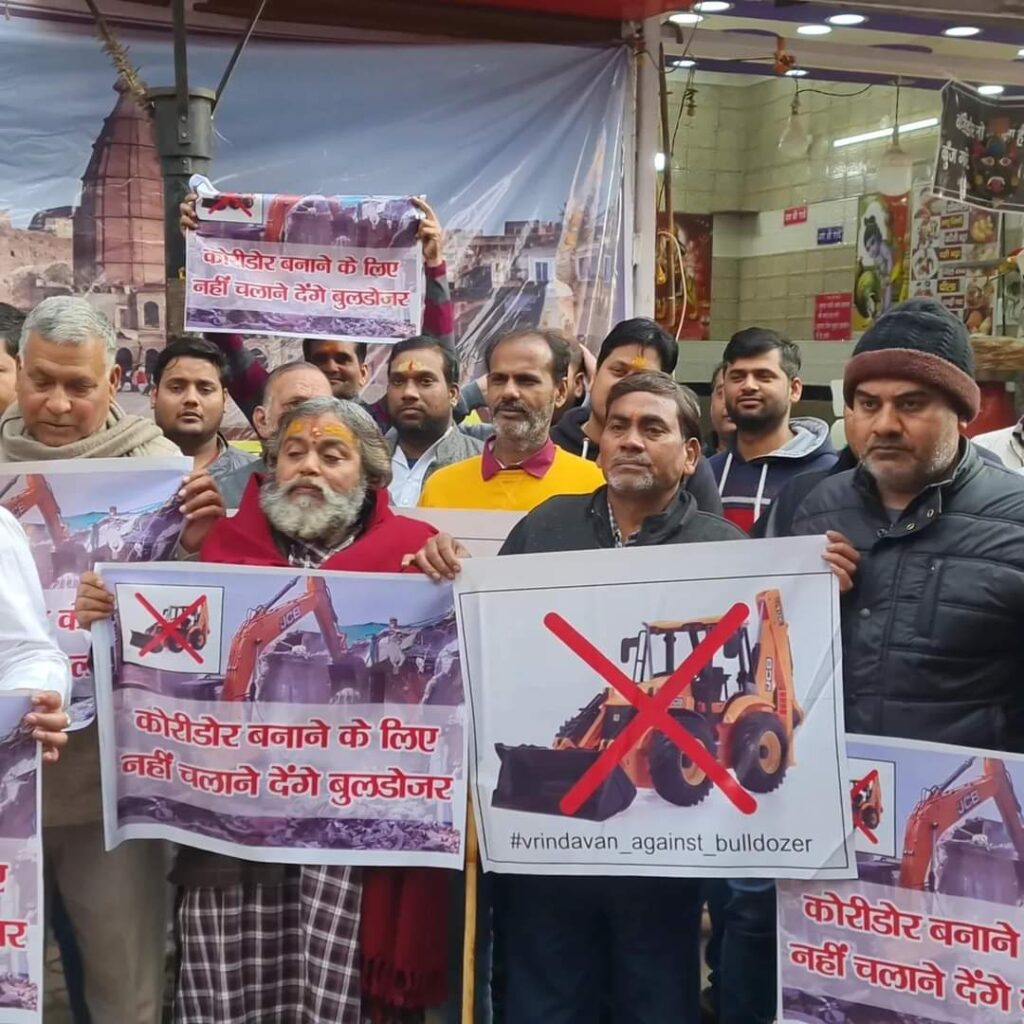
Moreover, Vrindavan’s two ancient temples, Madanmohan and Radhavallabh, will also be included in the upcoming Banke Bihari Corridor. Both these temples are ASI-protected monuments, with prohibitions on constructions in their 500 mtr vicinity.
The Madanmohan Temple is the most ancient shrine of Vrindavan. It was constructed on the dwadashaditya Tila between 1597 and 1627 by a rich Khatri merchant from Multan named Ramdas Kapoor. Radhavallabh is another temple in close proximity to Banke Bihari. The deity manifested by Lord Shiva was established by Mahaprabhu Hit Harivansh – the founder of Radhavallabh Sampradaya. The temple was first built around the year 1600 and for the second time after the mughal attack in 1842.
People are not convinced with the administration’s assurance that their antiquity and integrity will not be harmed in any way by the coming of the corridor. Besides, many of the Kunj Galis included in the Corridor plan are also recognised as heritage. They are currently being renovated under the World Bank’s pro-poor tourism development scheme. Protestors are pointing out this conflicting approach of the government, which recognises the kunj galis as heritage on one hand, and intends to replace them with the Corridor on the other.
The third argument against the Corridor is that it infringes upon the fundamental rights of the people, including the right to livelihood. According to the final survey report presented in the court, the 5-acre Banke Bihari Corridor will impact 323 buildings – residential and commercial – valued at 200-220 cr. Base rates of Rs. 60-70,000 per sqm for commercial buildings and Rs. 16000 per sqm for residential, were used to arrive at a valuation.
Using Google survey and government tax records, the 8-member team of PWD and tax department officials identified 323 buildings that will be affected by the upcoming corridor. Their valuation was decided on the basis of several parameters such as age of the building, nature of the building – residential or commercial, type of residents – owners or tenants/lessee, whether the occupants have valid documents to prove ownership, in whose name is the property registered, and whether the valuation as per tax records is sound.
The present Biharipura area of Vrindavan flourished around the ancient Has-Parihas Bageecha, a garden area of around 3600 sq ft where Raja Ratan Singh of Bharatpur built the Banke Bihari temple in 1863. The temple, however, covered only 1200 sq ft. The surroundings were used by the temple goswamis and high officials to build their settlements in the vicinity of the shrine. There also used to be four wells in the bageecha, the remnants of which can still be found. Over time regions grew in area and density, and became the densely populated area that it is today.
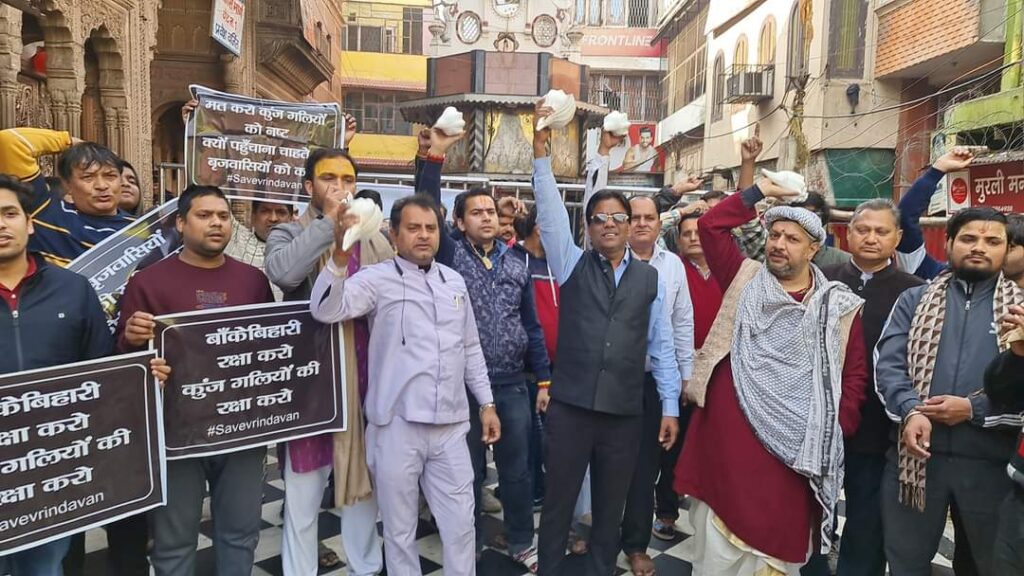
Many people who have either been living or owning properties here, do not have complete and or required documents except municipal corporation’s tax receipts and/or electricity bills to prove ownership, failing which they will not be able to claim compensation from the government.
The authorities have time and again assured people that their rights will be protected. House and shop owners will be compensated and those running businesses on rent will be allocated shops in the shopping complex that is part of the corridor plan. 800 sq mtr area has been allotted to Puja shops in the lower zone of the Corridor. Devotees will be able to buy puja items and other offerings over here. Shops that will be demolished for the project will be reconstructed in this space so that the livelihoods of the people affected remain safe. The shops will be of the same size and design. The number of shops has not been decided yet.
Further allaying people’s fears, Mathura MP Hema Malini said that the Corridor will be a win-win proposition for all. Not only will it boost tourism in Braj, but also the local economy as it will create more opportunities for business. However, Despite repeated assurances given by Mathura MP Hema Malini, DM Pulkit Khare, municipal commissioner Anunay Jha and other high-ranking officials, these apprehensions do not seem to die down.
Considering the seriousness of the situation many business owners and goswamis have approached the supreme court. Banke Bihari Traders Association secretary Amit Gautam said it is necessary to seek the intervention of the SC in order to protect the rights and interest of the common people.
Another important matter that has been brought to the court’s notice concerns the use of Banke Bihari temple treasury. The goswamis have raised objections against two conflicting high court orders dated December and October 2022, according to which, the temple funds may be used for development in and around the shrine.
Meanwhile, another movement for relocating the Banke Bihari temple to an open and larger space outside the busy market area has gained steam in parallel. Bihariji’s baggecha at Atalla Chungi has been put forward as a possible location. So far, Thakur Banke Bihari has resided in seven different places and temples.
Since his appearance in 1543 up to the nikunj lila pravesh of Swami Haridas in 1607 he resided in the nikunj at Nidhivan. From then on till 1719 he was in another temple by the name Rangmahal. Karauli’s queen took him to Karauli that year and consecrated him in a third temple where he stayed till 1721. A fourth temple in Bharatpur became his abode till 1724. He came back to Nidhivan and stayed in the new temple there till 1787. From there he was moved to another temple in the old city, and from there to the present temple in the same precincts in 1864.
Even as the imbroglio continues, recently some prominent spiritual leaders in Vrindavan led by Phooldol Bihari Das came out in support of the corridor. The expedient move has been strongly criticized by the protestors.



